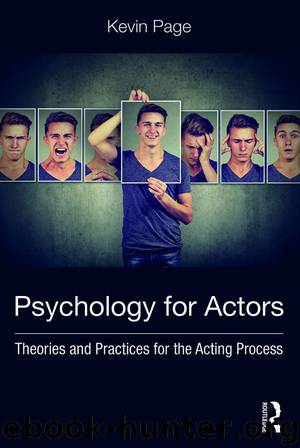Psychology for Actors by Kevin Page

Author:Kevin Page
Language: eng
Format: epub
Publisher: Taylor & Francis (CAM)
Published: 2018-07-30T16:00:00+00:00
Active Imagination
Jung’s active imagination exercise was based on a technique he stumbled upon during his own self-analysis. For Jung, it was a way of contacting the unconscious more directly than through dream images. You might think of the technique itself as a type of self-hypnotism or deep meditation where the barriers to unconscious contents are intentionally lowered and the person is essentially “inviting” the unconscious to come forward or “befriending” their unconscious. Both of these metaphors fail in some way to capture the actual experience of activating one’s own imagination in this way, as engaging this exercise is experiential and not conceptual. The value of working with active imagination, for the actor, is that it provides access to a wider range of self-knowledge and opens up a plethora of possible creative choices in the acting process that would be unlikely to arise from a conscious-only effort. Getting to know or “befriending” your own unconscious in this way will expand your own personality and has the potential to open up creative reserves you may well never have known that you had.
So, how does one “activate” their imagination? Jung was often vague on the specifics of his process, generally preferring to apply it directly to his patients as a tool of analysis. However, he did occasionally explain the method in writing:
This process [of active imagination] can, as I have said, take place spontaneously or be artificially induced. In the later case you choose a dream, or some other fantasy-image, and concentrate on it by simply catching hold of it and looking at it. You can also use a bad mood as a starting point, and then try to find out what sort of fantasy-image it will produce, or what image expresses this mood. You then fix this image in the mind by concentrating your attention. [This is where previous practice at meditation techniques would be helpful.] Usually it will alter, as the mere fact of contemplating it animates it. The alterations must be carefully noted down all the time, for they reflect the psychic processes in the unconscious background, which appear in the form of images consisting of conscious memory material. In this way conscious and unconscious are united, just as a waterfall connects above and below. A chain of fantasy ideas develops and gradually takes on a dramatic character: the passive process becomes an action. At first it consists of projected figures, and these images are observed like scenes in a theatre. In other words, you dream with open eyes. . . . It is very important to fix this whole procedure in writing at the time of its occurrence, for you then have ocular evidence that will effectively counteract the ever-ready tendency of self-deception. A running commentary is absolutely necessary in dealing with the shadow, because otherwise its actuality cannot be fixed.
(Jung, 1977, paragraph 706)
Download
This site does not store any files on its server. We only index and link to content provided by other sites. Please contact the content providers to delete copyright contents if any and email us, we'll remove relevant links or contents immediately.
Aircraft Design of WWII: A Sketchbook by Lockheed Aircraft Corporation(32192)
The Great Music City by Andrea Baker(31251)
Call Me by Your Name by André Aciman(20351)
The Secret History by Donna Tartt(18808)
The Art of Boudoir Photography: How to Create Stunning Photographs of Women by Christa Meola(18504)
Shoot Sexy by Ryan Armbrust(17637)
Plagued by Fire by Paul Hendrickson(17314)
Portrait Mastery in Black & White: Learn the Signature Style of a Legendary Photographer by Tim Kelly(16933)
Adobe Camera Raw For Digital Photographers Only by Rob Sheppard(16882)
Photographically Speaking: A Deeper Look at Creating Stronger Images (Eva Spring's Library) by David duChemin(16599)
Ready Player One by Cline Ernest(14495)
Pimp by Iceberg Slim(14321)
Bombshells: Glamour Girls of a Lifetime by Sullivan Steve(13952)
The Goal (Off-Campus #4) by Elle Kennedy(13474)
Art Nude Photography Explained: How to Photograph and Understand Great Art Nude Images by Simon Walden(12954)
Kathy Andrews Collection by Kathy Andrews(11709)
The Priory of the Orange Tree by Samantha Shannon(8858)
The remains of the day by Kazuo Ishiguro(8790)
Thirteen Reasons Why by Jay Asher(8767)
